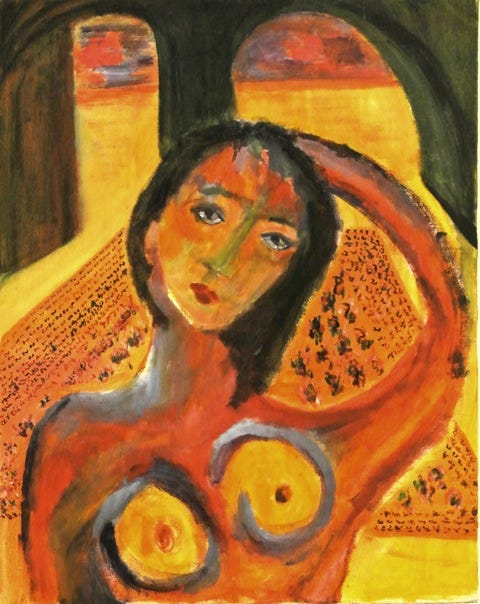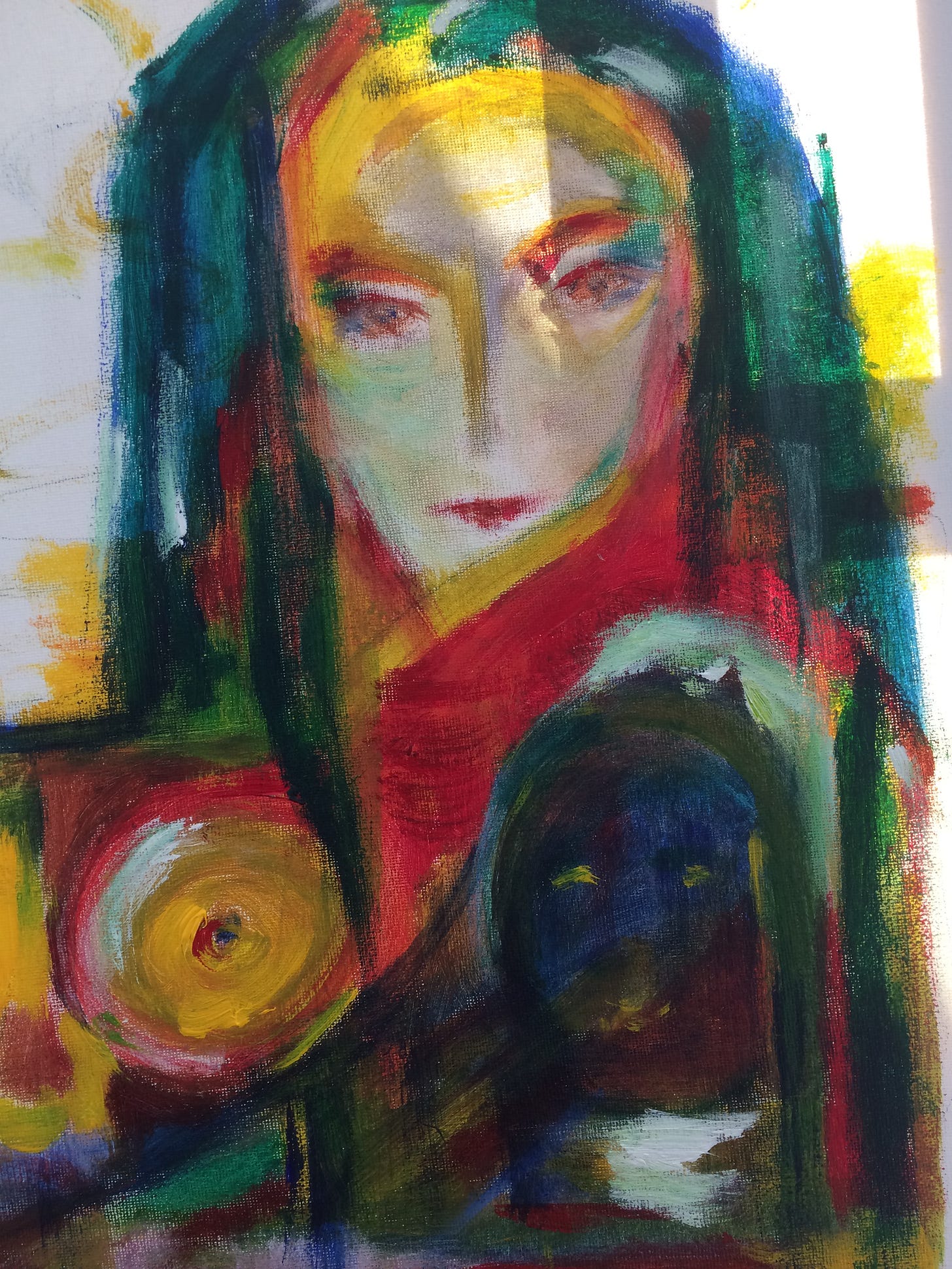This is the second in an occasional series of conversations with artists on the rich subject of Art and Spirituality.
Amber Chand, amberchand.com, is a visionary guide, painter and storyteller. Her journey as a global citizen began in Uganda where she was born into a Punjabi family that emigrated to East Africa from Northern India. She was sent to boarding school in England at the age of ten and in her early twenties exiled from Uganda during the regime of Idi Amin. This experience is recounted in her riveting one-woman show Searching for the Moon: A Heroine’s Journey, first produced in 2013. Amber has been painting off and on her entire adult life. I visited her in Great Barrington, Massachusetts where her pastel images of women’s faces and breasts had emerged from storage and were lined up on the floor around the room in a sacred circle. Our conversation with one another, surrounded by the paintings, was deep and spacious.
I can feel in your art that you come from the southern hemisphere. How are Africa and India represented in your paintings?
Growing up as an Indian child in East Africa, I was mesmerized by color—the deep reds of the land, the verdant greens of the equatorial forests, the azure blues of the expansive African skies. These bold colors of my African childhood find a place in my paintings. For here there is rhythm, vibrancy and a palette of richness. I am not afraid to paint boldly, to have colors collide with each other, to let shapes come out of the shadows—masks, silhouetted figures, dusty landscapes—my canvas now a playful dance arising from my African past.
When I paint, I paint quickly, sometimes ferociously. It is as if whatever energy is moving through me has to find its expression on the canvas. Otherwise, it will escape and be gone. The immediacy and intimacy of this process always astounds me. I never know what I will paint when I am faced with a blank canvas and I never know what will show up at the end. There is always surprise at the finished piece, a certain delight as I find myself saying, “so it was you who were seeking to emerge?”
There are certain gestures that I find particularly comforting. For instance, circles and arcs, which can soon transform into faces, breasts and domed archways. Here, it is my ancestral home in Northern India that calls to me with her spectral images of doe-eyed women with full breasts, her architectural forms of archways, pillars and courtyards, her sensuous sensibility that soon will find its way onto my canvas.
India and Africa are indeed powerful influences in all my work—one with its vibrant bold colors and rhythms, the other with its sensual lines and gestures. Here, on the canvas, they meet each other in a unique embrace of style, color and movement.
Beyond geography and culture, there is a sacred, ancient source for your work….both your paintings and your storytelling. How does the sacred manifest in your art and why are you partial to the word sacred, rather than the word spiritual?
I am drawn to the sacred. Whether it be through daily reflections written in my journals, my paintings and sketches, improvising on the piano, walks in nature, travel, my work as a storyteller and visionary guide. Living my life through the lens of the sacred offers a sweetness, no matter what the task at hand or the challenge and brings with it an immense sense of joy, gratitude, reverence and magic.
When I paint, I surrender to the canvas, to the paints and palette of colors, to the hand gestures—I lose myself in the process. Literally. That is why I paint quickly. I want to be inside the river of this energetic creative flow not outside of it. In this way, I become an empty vessel allowing whatever is seeking to come through to come through. This connection to the fountain of Source is what I mean by sacred.
I always paint to music—whether it be classical sitar or Indian flute, Gregorian chant or uplifting choral works—the music seems to carry me and mesmerize me into a place of deep quiet. From this place, I can paint with ease.
I prefer to use the word sacred rather than spiritual to describe this creative process because it feels like a deeply embodied experience rather than a transcendental one. My body becomes the sacred vessel, my hands the instrument that will now begin to trace a line, a gesture, a splash of color on the blank page or canvas. I am free to create without constraint or limitation. This requires intense focus and attention. A reverence for the process. A sacred act.
You use the word journey frequently as a framework for describing your ongoing becoming as a woman and an artist. We talked about thinking of becoming as an alternative to the loaded word future. How has becoming an elder impacted your painting and storytelling?
Throughout my life, I have felt as if I were simply visiting this world, that my home was not of this world, that I belonged elsewhere. So it has been natural to have experienced my life as a journey beckoned by the vision of the traveler, wanderer and nomad. Through the lens of the traveler, I find myself curious, spacious and openhearted, ready to explore and discover the world without being overly attached to it. I am simply passing through.
The spirit of the wayfarer has certainly played itself out in my life in dramatic ways. I was barely 10 years old when I left my childhood home in Uganda to spend the next decade at a boarding school for girls in the countryside in England. It was a difficult transition. Later, as a young 21 year old, I became a refugee—my family expelled from our home by a tyrannical African dictator. I arrived on the shores of the United States unanchored and rootless. These early experiences of exile and not belonging colored the way I engage with the world—and have showed up in my writings, paintings and philosophy of life.
“What will become of me now?” was once the cry of the anguished exile. But over the years, I have been drawn more to the potency of the question, “Who am I seeking to become?” I recognized that each part of life’s journey has its own unique texture, rhythm and mood. And that in becoming, we are allowing ourselves to flower into the most beautiful, authentic expression of who we are. Now, rather than wondering what the future has in store for me, I ask myself how I am going to shape the future I want to live in, how I am seeking to show up, who I am choosing to become.
Today, as I step into elderhood, I experience this sense of becoming even more potently. I call this a time of ripening rather than aging—resonating with the image of being plucked from the Tree of Life when it is my time, like a ripened fruit. Elderhood gives me permission to be fully enlivened by the life force that pulses through me while recognizing I am also being asked to release and let go of life, to one day join the lineage of my ancestors. Now it is legacy—what I am leaving behind—rather than ambition, that guides my days, no matter what I am doing or who I am becoming.
I will be curious to see how my paintings and writings will emerge during this time on my journey. How they will transform, as emissaries of my becoming. I am open, ready to be surprised.
An important part of your evolution seems to be connected to embracing the feminine. It’s almost as if all the themes in your life and your work, the curved feminine shapes you associate with India, the sacred belonging to Mother Earth, have coalesced in this homecoming. How are you experiencing this new door?
In a world ruled by symbols of the patriarchy, what I call toxic masculinity, I have spent much of my time delving into the realm of the feminine—trying to understand what it means to me, how it shows up in my world, and how to create a life where the feminine and masculine principles dance in exquisite balance.
It is the flow and fluidity of the feminine that seems to reveal itself in my paintings, whether in the strong faces that I am drawn to, the soft swirl of the body, the full breasts, the domed archways and rich textures.
When I write in my journals—a sacred practice for me—I prefer blank unlined paper so that I can scribe easily, my pen flows and words pour out of me without constraint. Like a river of expression, these journal entries speak to the rhythm and flow of my day, of what I see around me, what I am attending to. I am seeking to capture the moment in which I find myself with its myriad moods and thoughts, using my words as pools of reflection. I find this to be a deeply nourishing practice, an homage to the feminine, a tonic for the soul.
Stepping into the portal of the feminine is indeed a homecoming. At this time in my life, it is an invitation to choose rest as a radical act of compassion, to seek retreat as an act of profound kindness, to listen to what life asks of me and to receive it with openheartedness. The feminine invites me to step into the flow of my life as an awakening, a tender flowering. I am indeed grateful.
__________________________________________________________________________
My 2019 essay collection, Twilight Time: Aging in Amazement, is available directly from me, from Amazon or on order from your local bookseller.
Subscriptions to seventysomething on Substack are free of charge.






A wonderful and insightful conversation. I love her description of being in the "flow" when she paints.